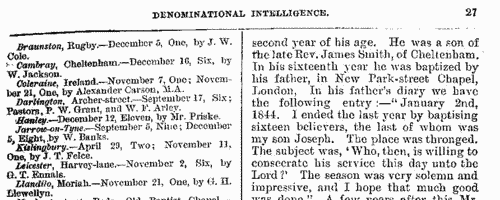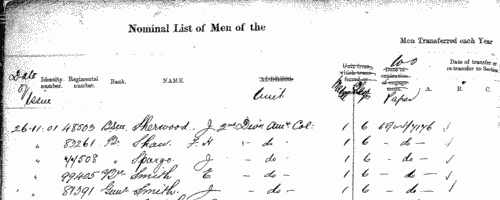Add this eBook to your basket to receive access to all 75 records. Our indexes include entries for the spelling haggett. In the period you have requested, we have the following 75 records (displaying 51 to 60): These sample scans are from the original record. You will get scans of the full pages or articles where the surname you searched for has been found. Your web browser may prevent the sample windows from opening; in this case please change your browser settings to allow pop-up windows from this site. Baptists
(1870)
The Baptist Messenger was produced monthly. The material indexed is mainly the Denominational Intelligence, i. e. the doings of the Baptist churches in Britain and Ireland, including summary lists of baptisms naming only the ministers. There are also some Baptist obituaries, and lists of donations to the Pastors' College at the Metropolitan Tabernacle in London. | Sample scan, click to enlarge

| Patentees of New Inventions
(1870)
Index of patentees and applicants for patents of inventions in 1870: giving full name of patentee (surname first); number of patent (in bold); date (within 1870); and subject-matter. Where the patentee was acting as agent for third parties, their names are given in italics in the subject-matter column. | Sample scan, click to enlarge

| Baptists
(1871)
The Baptist Messenger was produced monthly. The material indexed is mainly the Denominational Intelligence, i. e. the doings of the Baptist churches in Britain and Ireland, including summary lists of baptisms naming only the ministers. There are also some Baptist obituaries, and lists of donations to the Pastors' College at the Metropolitan Tabernacle in London. | Sample scan, click to enlarge

|  Shropshire Light Infantry fighting in Egypt
(1882) Shropshire Light Infantry fighting in Egypt
(1882)
The war medal roll for the Egyptian campaign of 1882 is annotated to show those men actually present at Tel-el-Kebir, and thereby also entitled to the Tel-el-Kebir clasp. In addition, there follows an almost duplicate roll of men entitled to the Bronze Star granted by the Khedive of Egypt in recognition of the campaign. The 1st battalion, The King's (Shropshire Light Infantry), left England for Egypt in 1882, and took part in this campaign before being sent on to Malta in 1883. The battalion returned for further duty in Egypt in 1885, but this roll, which compiled at Camp Abbasiyeh near Cairo in November 1882, refers only to the 1882 campaign. | Sample scan, click to enlarge

| Debtors, Insolvents and Bankrupts
(1886)
Bills of sale (binding assets to a creditor/lender), insolvencies and bankruptcies in England and Wales, July to September 1886 | Sample scan, click to enlarge

|  British artillerymen fighting in South Africa
(1899-1902) British artillerymen fighting in South Africa
(1899-1902)
The Queen Victoria's South Africa Medal was awarded (after her death, in the event) to all who had served honourably in the various campaigns in the Boer War. Returns were made from each unit, and consolidated into nominal roll, of which this is the one for the Royal Artillery. Confusingly, the ledgers used had originally been printed for a register of men transferred (or re-transferred after mobilization) to 1st Class Army Reserve. All the original column headings were therefore struck through, and the roll was prepared with this information: Date of Issue; Regimental Number; Rank; Name; Unit; Medal (a 1 indicating that a medal was awarded); [number of] Clasps; the reference to the source in the original returns, usually starting with AG for papers in the hands of the Adjutant-General, and 68/Art/ for the Royal Artillery records. The final column, normally left blank, was occasionally used for explanatory remarks. | Sample scan, click to enlarge

|  Queen's South Africa Medal: Royal Field Artillery: 64th Battery
(1901-1905) Queen's South Africa Medal: Royal Field Artillery: 64th Battery
(1901-1905)
The nominal roll for the Queen Victoria's South Africa Medal - awarded (after her death, in the event) to all who had served honourably in the various campaigns in the Boer War - was compiled from these returns from the individual units. Two sets of form were completed. The main one, as in the sample scan, dates from 1901 and gives regimental number, rank, and full name (surname first), followed by a series of columns relating to different actions - Belmont, Modder River, Paardeberg, Dreifontein, Wepener, Johannesburg, Diamond Hill, Belfast, Wittebergen, Defence of Kimberley, Relief of Kimberley, Defence of Mafeking, Relief of Mafeking, Cape Colony, Orange Free State, Transvaal, Rhodesia, Talana, Elandslaagte, Tugela Heights, Defence of Ladysmith, Relief of Ladysmith, Laing's Nek, and Natal; each entitled the man to a separate clasp to the medal, and a tick or a Yes in the appropriate column indicates the man's actual physical presence in that battle. A final column for remarks is important in those cases where the man was no longer in the unit, by removal, death or desertion. The second form that sometimes occurs was returned in 1905, and covers men entitled to the Second South African War Medal and Clasps. It lists men by number, rank and name, checks whether they had claimed the Queen's South Africa Medal, and then enquires as to their suitability as to three Colony Clasps, which could be awarded for service in the Cape, Orange Free, or Transvaal; whether entitled to Date Clasps (South Africa 1901 and South Africa 1902); whether also entitled to the King's South Africa Medal; any other corps in which served in South Africa; and remarks (such as becoming non-effective, forfeiture, &c.) WO 100/142
| Sample scan, click to enlarge

| Blind Annuitants
(1912)
The General Register of Blind Annuitants for 1912 listed nearly 6000 recipients of annuities from various charities and trusts in the British Isles. This index sets out the same information again in tabular form, giving: register number; surname; christian name or initials; full address; year of birth or age; amount of annual payment; year of appointment; recurrence (if renewed: yearly, weekly, or monthly); and abbreviated name of the charity. Many individuals were receiving sums from more than one source. Where (n) is given after the surname, it indicates a pension granted since the last previous edition; (+) shows an increase in pension; (-) a decrease. | Sample scan, click to enlarge

| Gardeners of Country Houses in Kent
(1917)
The Horticultural Directory and Year Book was published for 57 years by the proprietors of the Journal of Horticulture, but for 1917 it was acquired by the Gardeners' Chronicle, and a complete revision was undertaken. 'In order to ensure the accuracy of the entries, enquiries were sent to every one of the many thousand persons whose names appeared in the lists. Nor did the work cease there, for in cases where no reply was received, a second enquiry, and in some instances even a third, was sent out. Inasmuch as the War has called many gardeners from their normal avocations, it was not possible to obtain information with respect to all the changes which occurred during the year, and particularly during the closing months. It became necessary, therefore, either to go to press with a certain number of unverified entries or to omit them altogether. After careful consideration, the latter course was adopted, and every unverified entry has been omitted.'
Pages 75 to 187 of the work are occupied by 'A County Directory of the Principal Gardens in Great Britain and Ireland, including Name of Proprietor, Gardener, and Post Town.' This lists country houses possessing substantial gardens tended by a professional gardener. | Sample scan, click to enlarge

| Medical Practitioners in the Provinces
(1926)
The Medical Directory was split into several sections. The Provinces section covered all medical practitioners resident in England outside the London postal district (except those in Monmouthsire, who were listed under Wales). Each year a schedule was sent to each doctor to be returned to the publishers, so as to keep the directory up to date. In the directory the doctor's name is given first, in bold, surname first, in capitals; then current address. Next are the qualifications; the italic abbreviations in parentheses following the qualifications indicate the medical school at which they were gained. Then there is a list of posts and honours within the profession, starting with those then current; previous posts are preceded by the word 'late'. Finally, brief details are given of any publications. | Sample scan, click to enlarge

|
Research your ancestry, family history, genealogy and one-name study by direct access to original records and archives indexed by surname.
|












